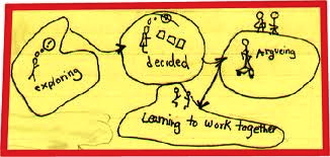 I believe that any type of adventure challenge unit in PE presents great opportunities to deepen both critical thinking and problem solving skills, especially when done so in a manner that allows students as much ownership as possible over their learning journeys. I have recently blogged about a new model of instruction that I am putting to the test in my current Athletics unit. A model that I have been toying with for a number of years, but am finally convinced that it is time to give it a go. You can read about my new approach to teaching Athletics here to get more of an idea about the model that I have been working on developing and putting into practice. Any of us who have done adventure challenge in the past know how great these units are for promoting communication, teamwork, collaboration, etc. Brain research suggests that excellent learning can take place when we give kids as many genuine and authentic opportunities as possible to design their own learning. As educators, we have a great responsibility to ensure that we provide our students with the best learning environment possible. Anything less than this is completely unacceptable in my opinion. I believe that in order to make this happen, we can and should give our students much greater control over their learning journeys. I have been fortunate enough to connect with some excellent PE practitioners through the blogs I follow, through Twitter, and through my own blog. When sharing the new model that I am putting to the test in Athletics, I connected with Mark Williams from the Overseas Family School of Singapore and Matthew Pomeroy (Matt blogs here). We began to discuss the idea of students designing their own learning and how this could be applied to adventure challenge. However, designing their own learning is strictly dependent upon them being fully aware of and understanding the student learning outcomes for the unit. Once introduced, these student learning outcomes guide and lead them on the journey of creating their own learning engagements. I believe that this will give the students a great sense of ownership paving the way for authentic learning to take place. Mark and I came up with a plan that will focus on the students creating three types of adventure challenge activities: games that can be played with no equipment, games that can be played with minimal and basic equipment, and a third type of game that is very much open-ended in the sense that they can choose as much of whatever equipment is needed. This will inevitably lead to the group having to explore, converse, debate about what is best, and ultimately decide upon different activities. Once the games are created, they will be be taught to their peers and feedback will be a big art of this process. Students must play the games and then give feedback in order for the games to be refined and improved upon. They must also decide on which assessment criteria best suits each game or activity, student driven in nature. During the unit, Mark and I will be sending each other adventure challenge games back and forth to try out with our own students. By the end of the unit, we are hoping to compile a list of student designed adventure challenge games that we can then share with other PE teachers. We will be sharing our experiences during the unit on my blog. Wish us luck!!
1 Comment
John Schneble (Frankfurt International School)
12/7/2017 02:13:16 am
Andy,
Reply
Leave a Reply. |
AuthorKAUST Faculty, Pedagogical Coach. Presenter & Workshop Leader.IB Educator. #RunYourLife podcast host. Archives
September 2022
|

 RSS Feed
RSS Feed